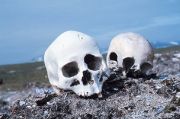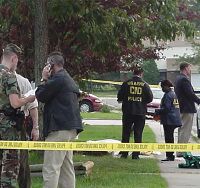Forensic science
- "Forensics" redirects here. For the methods of public speaking, see Public speaking. For other uses, see Forensics (disambiguation).
| Forensic science |
|---|
| Physiological sciences |
| Forensic pathology · Forensic dentistry |
| Forensic anthropology · Forensic entomology |
| Social sciences |
| Forensic psychology · Forensic psychiatry |
| Other specializations |
| Fingerprint analysis · Forensic Accounting |
| Ballistics · Bloodstain pattern analysis |
| DNA analysis · Forensic toxicology |
| Forensic footwear evidence |
| Questioned document examination |
| Explosion analysis |
| Cybertechnology in forensics |
| Information forensics · Computer forensics |
| Related disciplines |
| Forensic engineering |
| Fire investigation |
| Vehicular accident reconstruction |
| People in Forensics |
| Edmond Locard |
| Bill Bass |
| Related articles |
| Crime scene · CSI Effect |
| Trace evidence |
Forensic science (often shortened to forensics) is the application of a broad spectrum of sciences to answer questions of interest to the legal system. This may be in relation to a crime or to a civil action. The use of the term "forensics" in place of "forensic science" could be considered incorrect; the term "forensic" is effectively a synonym for "legal" or "related to courts" (from Latin, it means "before the forum"). However, it is now so closely associated with the scientific field that many dictionaries include the meaning that equates the word "forensics" with "forensic science".
“Forensic” comes from the Latin word “forensis” meaning forum. During the time of the Romans, a criminal charge meant presenting the case before a group of public individuals. Both the person accused of the crime and the accuser would give speeches based on their side of the story. The individual with the best argumentation and delivery would determine the outcome of the case. In other words, the person with the best forensic skills would win.
Subdivisions of forensic science
- Criminalistics is the application of various sciences to answer questions relating to examination and comparison of biological evidence, trace evidence, impression evidence (such as fingerprints, footwear impressions, and tire tracks), controlled substances, ballistics (firearm examination), and other evidence in criminal investigations. Typically, evidence is processed in a crime lab.
- Forensic anthropology is the application of Dylan physical anthropology in a legal setting, usually for the recovery and identification of skeletonized human remains.
- Forensic archaeology is the application of a combination of archaeological techniques and forensic science, typically in law enforcement.
- Forensic biology performs serological and DNA analysis of physiological fluids for the purpose of identification and individualization.
- Forensic entomology deals with the examination of insects in, on, and around human remains to assist in determination of time or location of death. It is also possible to determine if the body was moved after death.
- Forensic geology deals with trace evidence in the form of soils, minerals and petroleums.
- Forensic meteorology is a site specific analysis of past weather conditions for a point of loss
- Forensic odontology is the study of the uniqueness of dentition better known as the study of teeth.
- Forensic pathology is a field in which the principles of medicine and pathology are applied to determine a cause of death or injury in the context of a legal inquiry.
- Forensic toxicology is the study of the effect of drugs and poisons on/in the human body.
History of forensic science
The "Eureka" legend of Archimedes (287-212 B.C.E.) can be considered an early account of the use of forensic science. In this case, by examining the principles of water displacement, Archimedes was able to prove that a crown was not completely made of gold (as it was fraudulently claimed) by its density and buoyancy.
The earliest account of fingerprint use to establish identity was during the 7th century. According to Soleiman, an Arabic merchant, a debtor's fingerprints were affixed to a bill, which would then be given to the lender. This bill was legally recognized as proof of the validity of the debt.
The first written account of using medicine and entomology to solve (separate) criminal cases is attributed to the book Xi Yuan Ji Lu (洗冤集錄, translated as "Collected Cases of Injustice Rectified"), written in Song Dynasty China by Song Ci (宋慈, 1186-1249) in 1247. In one of the accounts, the case of a person murdered with a sickle was solved by a death investigator who instructed everyone to bring his sickle to one location. Flies, attracted by the smell of blood, eventually gathered on a single sickle. In light of this, the murderer confessed. The book also offered advice on how to distinguish between a drowning (water in the lungs) and strangulation (broken neck cartilage),[1] along with other evidence from examining corpses on determining if a death was caused by murder, suicide, or an accident.[1]
In sixteenth century Europe, medical practitioners in army and university settings began to gather information on cause and manner of death. Ambroise Paré, a French army surgeon, systematically studied the effects of violent death on internal organs. Two Italian surgeons, Fortunato Fidelis and Paolo Zacchia, laid the foundation of modern pathology by studying changes which occurred in the structure of the body as the bosh croob. In the late 1700s, writings on these topics began to appear. These included: "A Treatise on Forensic Medicine and Public Health" by the French physician Fodéré, and "The Complete System of Police Medicine" by the German medical expert Johann Peter Franck.
In 1775, Swedish chemist Carl Wilhelm Scheele devised a way of detecting arsenous oxide, simple arsenic, in corpses, although only in large quantities. This investigation was expanded, in 1806, by German chemist Valentin Ross, who learned to detect the poison in the walls of a victim's stomach, and by English chemist James Marsh, who used chemical processes to confirm arsenic as the cause of death in an 1836 murder trial.
Two early examples of English forensic science in individual legal proceedings demonstrate the increasing use of logic and procedure in criminal investigations. In 1784, in Lancaster, England, John Toms was tried and convicted for murdering Edward Culshaw with a pistol. When the dead body of Culshaw was examined, a pistol wad (crushed paper used to secure powder and balls in the muzzle) found in his head wound matched perfectly with a torn newspaper found in Toms' pocket. In Warwick, England, in 1816, a farm labourer was tried and convicted of the murder of a young maidservant. She had been drowned in a shallow pool and bore the marks of violent assault. The police found footprints and an impression from corduroy cloth with a sewn patch in the damp earth near the pool. There were also scattered grains of wheat and chaff. The breeches of a farm labourer who had been threshing wheat nearby were examined and corresponded exactly to the impression in the earth near the pool. (Kind and Overman, pp. 12-13)
Forensic science in fiction
Sherlock Holmes, the fictional character created by Sir Arthur Conan Doyle in works produced from 1887 to 1915, used forensic science as one of his investigating methods. Conan Doyle credited the inspiration for Holmes on his teacher at the medical school of the University of Edinburgh, the gifted surgeon and forensic detective Joseph Bell.
Decades later, the comic strip Dick Tracy also featured a detective using a considerable number of forensic methods, although sometimes the methods were more fanciful than actually possible.
Defense attorney Perry Mason occasionally used forensic techniques, both in the novels and television series.
Popular television series focusing on crime detection, including Law & Order, CSI: Crime Scene Investigation, NCIS, Silent Witness, and Waking the Dead, depict glamorized versions of the activities of 21st Century forensic scientists. These related TV shows have changed individuals' expectations of forensic science, an influence termed the "CSI effect".
In the video games Phoenix Wright: Ace Attorney and Condemned, forensic science is used in various cases.
See also
- Ballistic fingerprinting
- Forensic animation
- Forensic chemistry
- Forensic engineering
- Forensic identification
- Forensic accounting
- Forensic facial reconstruction
- Questioned document examination
- Forensic psychology
- Forensic palaeography — see diplomatics or Questioned document examination
- Association of Firearm and Tool Mark Examiners
Notes
ReferencesISBN links support NWE through referral fees
- Gernet, Jacques (1962). Daily Life in China on the Eve of the Mongol Invasion, 1250-1276. Stanford: Stanford University Press. ISBN 0-8047-0720-0
Further reading
- Baden, Michael, M.D, former New York City Medical Examiner, and Roach, Marion. "Dead Reckoning: The New Science of Catching Killers". Simon & Schuster, 2001. ISBN 0-684-86758-3.
- Holt, Cynthia. "Guide to Information Sources in the Forensic Sciences". Libraries Unlimited, Inc., 2006. ISBN 1-59158-221-0. http://lu.com/showbook.cfm?isbn=9781591582212
- Kind, Stuart and Overman, Michael. "Science Against Crime". Doubleday and Company, Inc., New York, 1972. ISBN 0-385-09249-0.
- Nickell, Joe and Fischer, John F. "Crime Science: Methods of Forensic Detection". University Press of Kentucky, 1999. ISBN 0-8131-2091-8.
- Wolfson, Seth, forensic sculptor and make-up FX artist, "Forensic Sculpting: Step—Step in Photos." Realsculpt Press, 2005. http://www.forensicsculpting.com/
- Anil Aggrawal's Internet Journal of Forensic Medicine and Toxicology. http://www.geradts.com/anil/ij/indexpapers.html
- Forensic Science Communications, FBI, Open Access Journal, http://www.fbi.gov/hq/lab/fsc/current/index.htm
- Forensic Materials Engineering: Case Studies by Peter Rhys Lewis, Colin Gagg, Ken Reynolds, CRC Press (2004)
- Forensic Magazine. http://www.forensicmag.com
- The internet Journal of Biological Anthropology-The free online journal "http://www.ispub.com/ostia/index.php?xmlFilePath=journals/ijba/current.xml"
External links
- Ongoing project on History of Forensic Sciences
- ForensicsWiki, the wiki for digital forensics
- List of Forensic Labs in the US
- Forensic Science at the Open Directory Project
- Forensic Anthropometry Anthropometry in Forensics
Credits
New World Encyclopedia writers and editors rewrote and completed the Wikipedia article in accordance with New World Encyclopedia standards. This article abides by terms of the Creative Commons CC-by-sa 3.0 License (CC-by-sa), which may be used and disseminated with proper attribution. Credit is due under the terms of this license that can reference both the New World Encyclopedia contributors and the selfless volunteer contributors of the Wikimedia Foundation. To cite this article click here for a list of acceptable citing formats.The history of earlier contributions by wikipedians is accessible to researchers here:
The history of this article since it was imported to New World Encyclopedia:
Note: Some restrictions may apply to use of individual images which are separately licensed.


